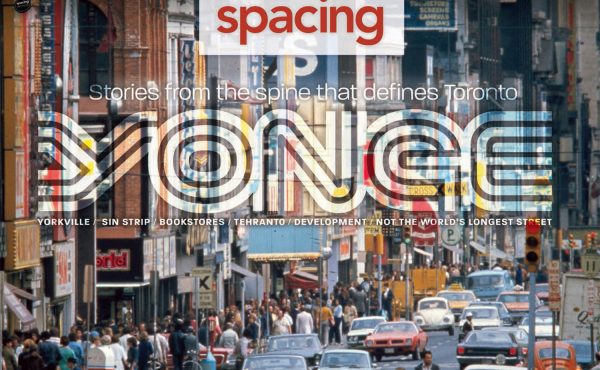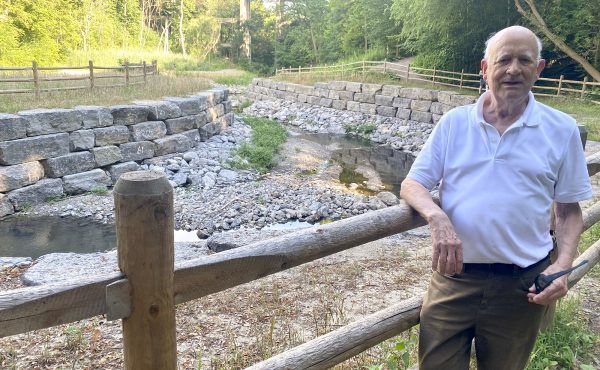[youtube]http://www.youtube.com/watch?v=-7_a2wa2dd4[/youtube]
The following is a reprint of my recent Psychogeography column in Eye Weekly.
The Gardiner Expressway: eternal plague on Toronto’s waterfront; killer of the civic soul; slayer of our beautiful dreams. The Gardiner is our most guilty piece of infrastructure, culpable for so much we think is wrong in this city; it’s a wonder it can even stand up as it continues to do. Calls to tear it down are common and when the idea is floated politically, everybody starts talking. All of this is remarkable because the Gardiner doesn’t really matter. At least not the way we think it matters.
The hand-wringing by Torontonians around its existence reminds me of Pierre Elliot Trudeau’s “Just Watch Me” conversation where, when asked about the reaction of people to his passing of the War Measures Act and soldiers on Canadian streets, he said: “Yes, well there are a lot of bleeding hearts around who just don’t like to see people with helmets and guns. All I can say is, go on and bleed, but it is more important to keep law and order in the society than to be worried about weak-kneed people who don’t like the looks of….”
He was cut off by the reporter, but I like to imagine he went on to talk about the concrete pillars of the Gardiner. The weak-kneed in Toronto are overly sensitive to it but ignore the real culprit in our “alienation” from the waterfront (if, in fact, there is one): the railway corridor. But trains are good and cars are bad, so the Gardiner gets the blame. When you remove the ideological anti-car sentiment, the main reason the Gardiner sucks is because its underbelly — the part you and I get to see up close — is a neglected wasteland. It doesn’t have to be this way.
Cities all around the world have gotten over the existence of big bulky infrastructure and done neat stuff underneath. In London, the Westway is a big concrete expressway that leads into the city centre. It’s a short walk from Paddington Station and Madame Tussauds, and people do walk to it because London has converted exactly the same kind of post-war Gardiner environment into a linear park that has a soccer pitch, basketball nets and a skate park — all protected from the English rain by a giant concrete umbrella.
In other places in London and the rest of the UK, people inhabit the spaces underneath transportation infrastructure. Under Glasgow’s Central Station, an arts centre/theatre/nightclub called The Arches has existed for years. Of course, the comparison here is not completely fair as these most Dickensian of places (that word used to mean really bad and terrible) are now beloved, while modern concrete is treated like the new-Dickens no-go zone. In other cities around the UK, stores and other businesses are tucked in underneath these structures, filling in the space and continuing the urban fabric rather than leaving it empty. In Toronto, city engineers don’t like that because it makes their jobs a bit harder. But they’re smart and will get over it if we tell them to figure out how to accommodate new stuff underneath.
Try walking along the underside of the Gardiner, from around the Distillery to the CNE, where it finally touches ground. While some parts are filled with Lake Shore Boulevard, most of it consists of empty, orphaned spaces. At times the Gardiner is lofty and cathedral-like while in other places, like by Cityplace, just west of Spadina, the lower deck is intimate and (when some forward-thinking imagination is employed) downright cozy.
Though we’ve been living with our freeway for a half-century now, we’re only beginning to recognize the potential of the space underneath. Two weeks ago, Waterfront Toronto announced a plan to build “Underpass Park” in a Gardiner-like space where Eastern, Adelaide and Richmond meet just west of the Don River. Until recently, when the entire West Don Land area was razed for redevelopment, this was an industrial zone and the space under these roads was where film companies stored New York City cabs. The plans by Phillips Farevaag Smallenberg of Vancouver and Toronto’s The Planning Partnership look like a cross between London’s Westway and Canoe Landing Park, the new “red canoe” park these two same firms (along with Douglas Coupland) designed for the City of Toronto between Bathurst and Spadina, adjacent to the Gardiner.
When the park was announced, there were cries from weak-kneed types that went something along the lines of “you can’t have a park near all those cars.” There are some pollution issues certainly, but that’s everywhere. All those new condo buyers who bought expensive perches along the Gardiner aren’t stupid — if it were an awful place to be, they would buy elsewhere.
To see the potential of these spaces, go stand underneath Watertable, a public artwork installed by Toronto artists Lisa Steele and Kim Tomczak that illuminates the underside of the Gardiner by Fort York with undulating waves of light that mark where the original shoreline of Lake Ontario was. It’s about as calm and tranquil as urban Toronto gets. It’s not silent, but neither is it loud. It’s a useful urban space.
More is happening by Fort York, where a new visitor’s centre is about to be built on the north side of the roadway, parallel to the expressway. The approach out to Fort York Boulevard will be sheltered by the Gardiner overhead, creating an all-weather, safe-from-UV-rays, public space. Full disclosure: I’m on the board of Fort York and have been excited about these two projects for what they mean for the Fort, but also what they do for Toronto’s relationship with Gardiner.
Ultimately, every time a proposal to tear down the expressway is floated, a huge amount of political capital is spent and wasted. Drivers feel under attack and post-Gardiner proposals always include an extremely wide and busy arterial road that nobody will be happy about (that is, it isn’t going to be replaced with College Street). To stop all that Trudeau bleeding, we just need to make the underside nice.




20 comments
I love this attitude in this article. Underpasses are a neglected public space that could be made more beautiful. Do the walls have to be bare concrete? Can’t they be bricked, or covered in low-light plants? Something to absorb noice? Can the lighting be more appealing? Better looking sidewalks with street furniture to separate it from the road? Can there be slits in the road deck to let in some natural light? Waterfountains and benches? Art?
Is it right to view the Gardiner as a whole? This doesn’t need to be an all-or-nothing scenario. Yes, the railways are a significant barrier as you move West, but from Jarvis Street eastward they don’t amount to much.
The visceral reaction some people have to even studying removing that small piece of the highway is crazy.
Finally someone with some sense! It should be obvious the Gardiner itself isn’t the problem, but doubters should go for a walk down Strachan to the lake and back up Bathurst, to see whether the gardiner or Lakeshore are harder to cross, and another down Carlaw, along the south side of Lakeshore (’cause you have to cross it for the full experience) and back up Leslie, to experience the full horror of what a gardiner-free waterfront would be like (at Leslie the old off ramps at least blocked your view so you didn’t have to see all the ugliness of that intersection at once). On the other hand when I was in sydney.au I walked under their waterfront expressway and barely noticed, because it’s just normal downtown streets beneath.
GO Tranist is pretty good if you happen to be going where it goes at the times it goes, but mass transit isn’t an alternative for a lot of out of town trips, because there isn’t any.
Also I think some people sometimes forget, but the city doesn’t end at John Street or even at Parliament. There’s still half of Toronto and all of Scarborough to the east, and we sometimes like to go places too.
I thought the Smallenberg plan misses an enormous opportunity to solidify an existing use of the nether regions of the Gardiner, one that takes advantage of its gritty and urban character. Why not take some of those areas and build skateboard or BMX facilities for youth, graffiti walls, and perhaps even some kind of interesting bike path network that takes advantage of the industrial ambiance. I simply don’t see people relaxing under those off-ramps, sipping coffee and chatting.
But we do know that there are places under the Gardiner now that are used by boarders, because the gritty setting meshes well with the nature of the activity. In Vancouver, in fact, a group of skateboarders found an abandoned bus tunnel under a viaduct a few years back, cleaned it out, built ramps, painted the place from top to bottom, and called it Leeside, after the founder, who was killed in a fight. I understand Vancouver’s Parks Board has finally taken over Leeside as part of its large inventory of skateboard parks. This kind of thing makes more sense to me than passive, landscaping-driven ideas that pre-suppose the presence of people who just want to stroll or sit, which they could do in far more peaceful settings just a few blocks south…
The railway lands present an amazing opportunity, but the Gardiner warrants only a few underside improvements, until some paradigm shift makes it profitable for the city and exciting for the people to do anything major integrating both transitional features along the south.
I am still amazed that some people think that Ripley’s Aquarium is a suitable Toronto tourism idea, as if there should be no distinction or appreciation of locality in the higher goal of tourism as an industry. I.e. a tourism destination should have all the same things that other ones have. Is that in case the airlines get mixed up?
I always thought that Lakeshore Blvd. under the Gardiner was the real barrier. It’s a six-lane highway in its own right.
Though in my better days I can appreciate the Gardiner and the drive along it never fails to thrill me just a little – for me this article talks about the route as if it were a few lanes of traffic suspended in air, which it is not. One of the significant ways that the Gardiner is a barrier is in the on-and-off ramps and the traffic they bring. How many places along the Gardiner are no-go-zones for walkers or bicyclists (like the west side of Spadina or Yonge / Harbour) due to the ramps? They take up a lot of space and are major obstacles. They could be repaired to some extent simply by changing the rules, but that seems unlikely to happen.
I also think that, as an expressway that primarily brings people to, rather than through, downtown, alternatives to the Gardiner would work rather well in Toronto, and might actually be an improvement to the jockeying for onramp space that we see currently.
Shawn, a very well thought out piece.
“Cities all around the world have gotten over the existence of big bulky infrastructure…”
Yeah, but cities that removed that infrastructure — and I’m thinking specifically of San Fransisco — did much better than just ‘getting over it’.
Has praying for an earthquake become the only option for really dealing with the Gardiner?
This is a great idea. Similar to Shawn, and many other commenters, I feel that the Gardiner is not the main barrier to the Waterfront, but rather the Lakeshore or the railway lands are much more the culprit of this feeling of a barrier.
It would be great to turn the top of the Gardiner into a park much like the High Line in NYC. I think it would be a great way to preserve the unique view of the city you get from the top of the Gardiner and provide an additional recreational and agricultural space (more viable when the # of cars is greatly reduced)for Toronto’s citizens. That way you could have recreation up top, and a viable commercial space on the bottom.
Too bad we couldn’t do something grand with that space south of Front Street. We could have buried a stretch of the rail corridor and Gardiner, and created a massive central park surrounded by towers on all sides.
That being said, in terms of the reality today, there’s a roadway under the Gardiner for a substantial stretch. Hence, there’s no opportunity for businesses there. Also in comparison to the rail corridor, the Gardiner is the greater barrier because when you cross the rail corridor on foot, you’re completely separated from the railway. When you cross the Gardiner, there are always turning vehicles which could leave you in a wheelchair for the rest of your life. It’s a worst case scenario of course, but it’s a major part of the psychological barrier.
blamb> When I went to SF I saw the replacement for the Embarcadero freeway – a huge, fat, arterial road. City on one side, the Bay on the other. Not terrible, but as I say in the piece, it ain’t College Street.
Yeah, but it’s a fresh gash and the city hasn’t had time to make sense of it yet. The open space allows for possibilities for knitting the space into the city over time. Even Lakeshore East won’t seem so barren in 30 years when the trees have grown and when the surrounding buildings don’t have their backs turned towards the street.
Another “huge, fat, arterial road” replacing an elevated highway to consider: West Street in Manhattan…
Yes! Thank you for talking about this. I’m always trying to convince people that the Gardiner itself isn’t a particularly big problem and that a huge at grade road would probably be no better if not worse.
You can make the Gardiner pretty as much as you want, Toronto was just called the worst american city for traffic and congestion… Even Los Angeles and NYC are doing better than us. Seams like it’s much more than the “look” or the “safety” of the road system of our city that is to be studied.
“When I went to SF I saw the replacement for the Embarcadero freeway – a huge, fat, arterial road.”
Having had personal experience with the Embarcadero, I would much rather have it — the huge, fat, entirely non-arterial, low-speed boulevard — than Gardiner’s ramps and the Lakeshore to deal with.
Why exactly do we need an arterial across the entire bottom of the city by the lake? If its main use is travel to and from downtown, we can do better than a through road, elevated or not.
Take away the ramps and the Lakeshore and I won’t give a crap about the Gardiner, but really, that’s not going to happen, is it?
The ramp at Spadina is terrible. Otherwise, there are some ramps along the way. So? Check the one just west of Yonge. It comes down, a nice sidewalk is next to it with people walking on it.
thank you for articulating this argument, i completely agree. the rail lands and lakeshore blvd are very much to blame for our disconnection to the waterfront, along with the gardiner. use of all these spaces need to be intensified and there are many options once you get a little creative as you have done. Now that there are so many people living right by those lands there is a natural group of people using them all the time, and more people visiting on weekends etc once there is a critical mass of urban vitality.
I would like to see a proposal worked out where lakeshore is reduced/removed where possible, and gardiner intensified if necessary, leaving the ground more free for north/south developments that bring people down to the water.
The problem with the Gardiner is the traffic noise. I walk from King West to the lake on a regular basis and the rail corridor isn’t pretty but I can look away. I can’t get away from the constant noise high speed vehicles (which is much louder than vehicles accelerating).
Although I agree that San Francisco is much better now, we don’t need to look further than the eastern portion of the Gardiner that was taken down a decade ago. The area around Lakeshore and Leslie is much better than before.